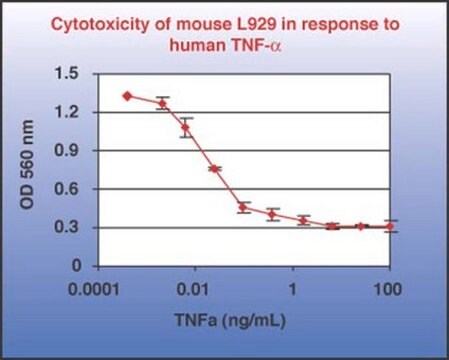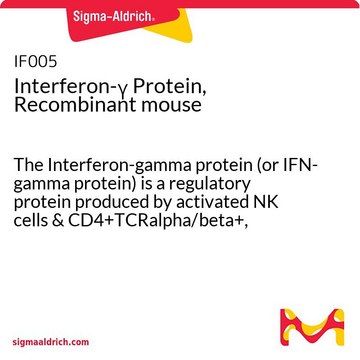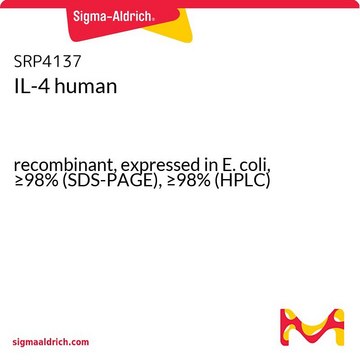GF305
IFN- γ Protein, Human Recombinant Animal Free
The Interferon gamma (or IFN-γ protein) is an acid-labile interferon produced by CD4 & CD8 T lymphocytes as well as activated NK cells. Manufactured using all non-animal reagents.
Sinónimos:
IFN, Interferon Gamma, IFNG, IFN Gamma
Iniciar sesiónpara Ver la Fijación de precios por contrato y de la organización
About This Item
UNSPSC Code:
12352202
eCl@ss:
32160405
NACRES:
NA.77
Productos recomendados
Quality Level
assay
>98% (SDS-PAGE and HPLC)
impurities
<0.1 μg/mg protein endotoxin (<1EU/μg)
NCBI accession no.
UniProt accession no.
shipped in
dry ice
General description
Interferon gamma (IFN-γ) is an acid-labile interferon produced by CD4 and CD8 T lymphocytes as well as activated NK cells. IFN-γ receptors are present in most immune cells, which respond to IFN-γ signaling by increasing the surface expression of class I MHC proteins. This promotes the presentation of antigen to T-helper (CD4+) cells. IFN-γ signaling in antigen-presenting cells and antigen-recognizing B and T lymphocytes regulate the antigen-specific phases of the immune response. Additionally, IFN-γ stimulates a number of lymphoid cell functions including the anti-microbial and anti-tumor responses of macrophages, NK cells, and neutrophils. Human IFN-γ species-specific and is biologically active only in human and primate cells. Recombinant human IFN-γ is a 16.7 kDa protein containing 143 amino acid residues.
Quality
Bioactivity assay: Determined by its ability to induce apoptosis in HeLa cells. The expected ED50 for this effect is 5.0-10.0 ng/ml.
Physical form
Recombinant animal free human IFN- γ is manufactured using all non-animal reagents
Storage Class
11 - Combustible Solids
wgk_germany
WGK 1
Certificados de análisis (COA)
Busque Certificados de análisis (COA) introduciendo el número de lote del producto. Los números de lote se encuentran en la etiqueta del producto después de las palabras «Lot» o «Batch»
¿Ya tiene este producto?
Encuentre la documentación para los productos que ha comprado recientemente en la Biblioteca de documentos.
Hong-Lin Luo et al.
Cancer cell international, 21(1), 422-422 (2021-08-12)
Epithelial-mesenchymal transition (EMT) promotes migration, invasion, and metastasis of hepatocellular carcinoma (HCC) cells. The molecular mechanisms behind EMT and metastasis in HCC remain unclear. Microarray analysis was used to identify lncRNAs expression during polarization of U937 macrophages from M2 to
Nuestro equipo de científicos tiene experiencia en todas las áreas de investigación: Ciencias de la vida, Ciencia de los materiales, Síntesis química, Cromatografía, Analítica y muchas otras.
Póngase en contacto con el Servicio técnico







